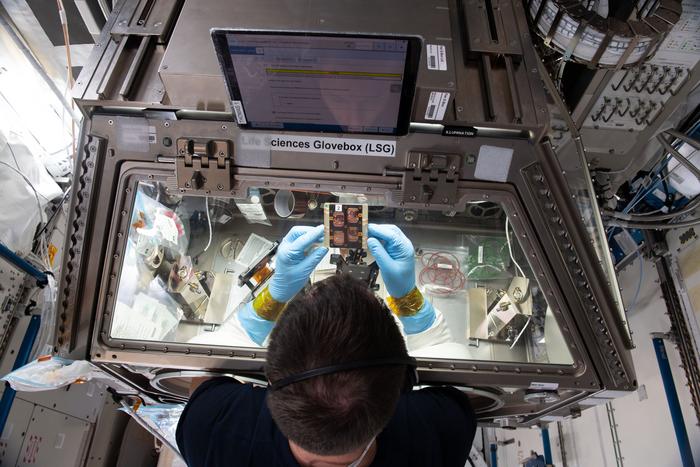A gentle rumble ran under Ngan Huang’s feet as a rocket carrying her research—live, human muscle cells grown on scaffolds fixed on tiny chips—lifted off, climbed, and disappeared into the sky to the International Space Station National Laboratory. These chips would help Huang better understand muscle impairment, often seen in astronauts and older adults, and test drugs to counter the condition.

Credit: NASA
A gentle rumble ran under Ngan Huang’s feet as a rocket carrying her research—live, human muscle cells grown on scaffolds fixed on tiny chips—lifted off, climbed, and disappeared into the sky to the International Space Station National Laboratory. These chips would help Huang better understand muscle impairment, often seen in astronauts and older adults, and test drugs to counter the condition.
Now, the results are back. Reporting in a study published July 25 in Stem Cell Reports, Huang’s team showed that space-travelling muscle had metabolic changes that indicate impaired muscle regeneration and gene activities associated to age-related muscle loss called sarcopenia. But drug treatment partially prevented microgravity’s adverse effects.
“Space is a really unique environment that accelerates qualities associated with aging and also impairs many healthy processes,” says Huang (@NganHuang), an associate professor at Stanford University. “Astronauts come back with muscle atrophy, or a reduction of muscle function, because the muscle isn’t being actively used in the absence of gravity. As space travel becomes more common and available to civilians, it’s important to understand what happens to our muscle in microgravity.”
To understand the effects of microgravity on muscles, the researchers launched muscle chips—bioengineered packages of oriented muscle cells on patterned biomaterials that mimic the structure of real muscles—into space to grow for seven days under astronauts’ care.
When the researchers compared muscle cells grown in microgravity to those grown on Earth, they found impaired muscle fiber formation. They also discovered differences in their gene activity and protein profile. Genes related to mitochondrial function, which muscles get their energy from, were compromised, and genes associated with fat formation were boosted. These findings suggest microgravity can lead to dysfunctions in muscle regeneration.
Space-traveled muscles also have gene activities that somewhat resemble muscles with sarcopenia, which most commonly affects people ages 60 and older.
“We think our research on muscle chips in microgravity may have broader implications on sarcopenia,” says Huang. “Sarcopenia usually takes decades to develop on Earth, and we think that microgravity may have some ability to accelerate the disease process in orders of days.”
In a proof-of-concept experiment to test the muscle chip for drug screening, the astronauts spiked the chips with drugs to treat sarcopenia or enhance muscle regeneration. The treatment partially mitigated some of the negative effects of microgravity on the muscles, preventing a metabolic shift to fat formation. Looking into gene activity patterns, the drug-treated muscle in microgravity is more similar to samples from Earth than untreated samples in microgravity.
Because space research is labor and resource intensive, the current study is a one-time experiment, and a limited number of samples were allowed to board the rocket. The scientists are now deploying equipment that simulates microgravity to overcome some of those limitations and aid their research in space. Huang’s muscle chips are scheduled to embark on another space journey in 2025 to continue the research on identifying drugs for treating microgravity-induced impairment in muscle regeneration.
“This concept of engineered tissue chip platform in microgravity is a potentially transformative tool that could allow us to study a variety of diseases and do drug screening without animal or human subjects,” says Huang.
###
This work was supported by the US National Institutes of Health, the US Department of Veterans Affairs, the National Science Foundation, the Center for the Advancement of Science in Space, the American Heart Association, the US Department of Veterans Affairs.
Stem Cell Reports, Kim, Ayan, and Shayan et al. “Skeletal Muscle-On-A-Chip in Microgravity As a Platform for Regeneration Modeling and Drug Screening”
Stem Cell Reports (@stemcellreports), published by Cell Press for the International Society for Stem Cell Research (@ISSCR), is a monthly open-access peer-reviewed publication communicating basic discoveries across the spectrum of stem cell research and translational and clinical studies. The journal focuses on shorter, single-point manuscripts that report original research with conceptual or practical advances that are of broad interest to scientists and clinicians across the continuum of stem cell science and application. Visit http://www.cell.com/stem-cell-reports. To receive Cell Press media alerts, please contact press@cell.com.
Journal
Stem Cell Reports
Method of Research
Experimental study
Subject of Research
Cells
Article Title
Skeletal Muscle-On-A-Chip in Microgravity As a Platform for Regeneration Modeling and Drug Screening
Article Publication Date
25-Jul-2024



